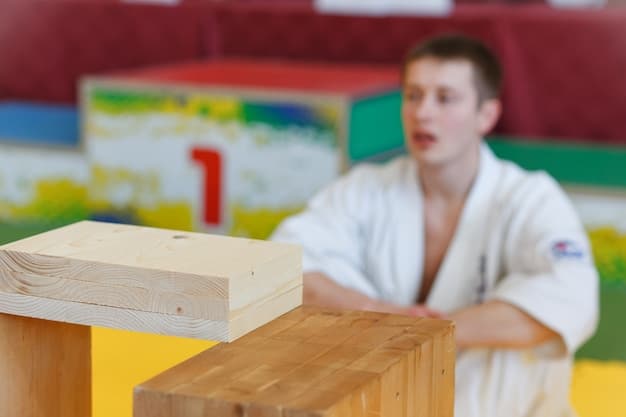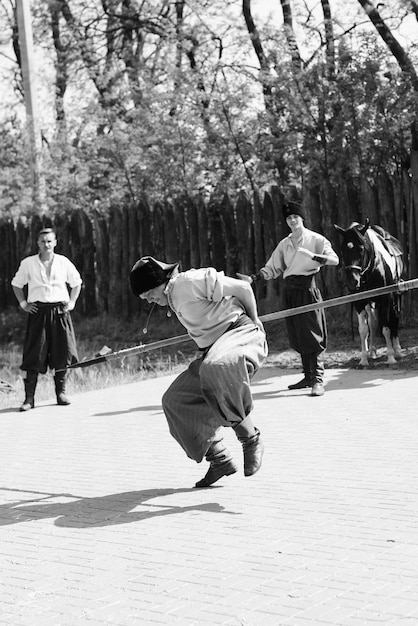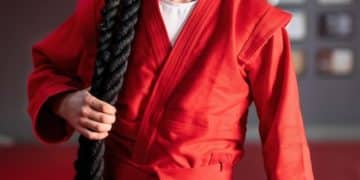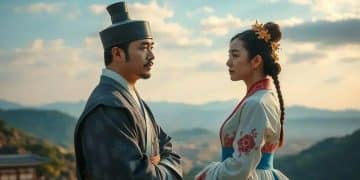Taekwondo’s Journey: From Ancient Korea to US Training Centers

Exploring the History of Taekwondo: From Ancient Korea to US Training Centers reveals the martial art’s evolution from ancient Korean military practices to its current popularity in US training centers, highlighting key historical milestones and cultural influences.
The journey of taekwondo is a fascinating tale of cultural evolution and adaptation. Exploring the History of Taekwondo: From Ancient Korea to US Training Centers unveils how this martial art transformed from ancient Korean military practices to a globally recognized sport and fitness discipline, with a significant presence in the United States.
The Ancient Roots of Taekwondo in Korea
Taekwondo’s origins are deeply intertwined with the Korean peninsula’s rich history. It evolved from various ancient martial arts practiced by Korean military groups. Understanding these early influences provides context for taekwondo’s development.
Early Korean Martial Arts
The earliest forms of taekwondo can be traced back to ancient Korean kingdoms such as Goguryeo, Baekje, and Silla. Warriors needed unarmed combat skills, which led to the development of indigenous martial arts.
- Subak: This early martial art focused on hand-to-hand combat techniques, laying a foundation for future taekwondo practices.
- Taekkyon: Known for its emphasis on kicking and leg techniques, Taekkyon influenced the striking aspects of taekwondo.
- Hwarangdo: Practiced by elite youth warriors, Hwarangdo incorporated martial arts training alongside moral and philosophical education.

These early martial arts were not just methods of self-defense; they were integral to military training and instilled discipline, loyalty, and physical prowess in practitioners. Over centuries, these techniques would gradually coalesce into what we recognize today as taekwondo.
The Evolution of Taekwondo During the Korean Dynasties
The Korean dynasties played a significant role in shaping taekwondo. Under different rulers and through periods of both peace and conflict, taekwondo evolved and adapted, incorporating new techniques and philosophical underpinnings.
The Joseon Dynasty and Martial Arts
During the Joseon Dynasty (1392-1910), martial arts continued to be a part of military training and cultural practices. However, traditional forms became less emphasized as the kingdom prioritized Confucian ideals and literary pursuits.
Despite a decrease in official support, martial arts persisted among the common people, often practiced in secret. This helped preserve ancient techniques and kept the spirit of martial arts alive, ensuring that they would be available for revival in later eras.
Japanese Colonial Period (1910-1945) and Suppression
The Japanese colonial period brought significant suppression of Korean culture, including martial arts. The Japanese colonial government tried to suppress many Korean traditions, which included banning the public practice of native martial arts.
- Banning of Korean Martial Arts: The Japanese colonial government prohibited the practice of traditional Korean martial arts to undermine Korean identity.
- Influence of Japanese Martial Arts: Japanese martial arts like karate and judo were introduced, influencing the development of Korean martial arts during this period.
- Underground Practice: Despite the ban, some Koreans continued to practice martial arts secretly, preserving their heritage.
The colonial period was a challenging time for Korean martial arts. It forced practitioners to adapt and preserve their art in the face of cultural suppression. This era’s influence is still visible in taekwondo today through some techniques and philosophies.
The Post-Korean War Revival and Unification of Taekwondo
Following the Korean War, there was a strong movement to revive and unify Korean martial arts. This era saw the establishment of various kwans (schools), each contributing to the standardization of taekwondo.
The Establishment of the Kwans
Several kwans (schools) were established, each with unique techniques and philosophies. These included Chung Do Kwan, Moo Duk Kwan, and Song Moo Kwan, among others. Each kwan had its own style and leadership.
The initial focus was on rebuilding and promoting martial arts as a source of national pride and physical fitness. The kwans played a crucial role in developing and spreading different styles of the arts throughout Korea and internationally.
Unification Efforts
Efforts were made to unify these diverse styles into a single Korean martial art. General Choi Hong Hi played a key role in this process, advocating for the creation of a standardized form of taekwondo.
- Standardization of Techniques: The unification process aimed to standardize techniques, forms, and terminology for taekwondo.
- Creation of a Unified Style: This effort resulted in a more cohesive and recognized martial art, which would eventually be recognized globally.
- Political Influences: Political tensions and differing opinions among kwan leaders created complexity.
The unification process was complex, involving negotiations, compromises, and political considerations. Despite these challenges, it ultimately led to the creation of a more unified and globally recognized form of taekwondo.

Taekwondo’s Globalization and Spread to the United States
Taekwondo’s transition from a Korean martial art to a global phenomenon is marked by its spread to various countries, including the United States. The mid-20th century saw increasing interest and participation in taekwondo worldwide. Understanding the initial stages of this growth is crucial.
Early Introduction to the US
Taekwondo was first introduced to the United States primarily through Korean martial arts instructors who immigrated or were stationed in the US military. These instructors began teaching small groups, laying the foundation for future growth.
Many Korean martial arts experts arrived in the USA bringing the art with them. Their initial presence involved establishing small dojangs (training halls) and teaching to local communities.
Growth and Popularization
As taekwondo gained traction in the US, it became increasingly popular, attracting a diverse range of practitioners. This growth was supported by martial arts demonstrations, competitions, and the increasing recognition of taekwondo as a sport and fitness activity.
- Martial Arts Demonstrations: Public demonstrations showcased the dynamic techniques and physical conditioning aspects of taekwondo.
- Competitions and Tournaments: Local and national tournaments provided opportunities for practitioners to test their skills and gain recognition.
- Media Coverage: Increased media coverage helped to popularize taekwondo and attract new participants.
The globalization of taekwondo was not without challenges. Different styles and interpretations of taekwondo emerged, leading to debates about standardization and authenticity. However, the martial art continued to evolve and adapt to different cultural contexts.
Taekwondo in US Training Centers Today
Today, taekwondo is widely practiced in numerous training centers across the United States. The martial art has evolved to cater to various interests, from competitive sport to self-defense and fitness.
Diverse Training Programs
US training centers offer a range of programs tailored to different age groups, skill levels, and interests. These include classes for children, adults, and competitive athletes, emphasizing various aspects of taekwondo training.
The programs commonly include a focus on forms (poomsae), sparring (gyeorugi), self-defense techniques, and physical conditioning. Instructors often blend traditional and modern teaching methods.
Competitive Taekwondo
Competitive taekwondo is a significant aspect of the martial art’s presence in the US. American athletes participate in national and international competitions, including the Olympic Games.
Organizations like USA Taekwondo support and promote competitive taekwondo, providing training resources, coaching, and tournament opportunities. The US has produced several successful taekwondo athletes who have medaled at the Olympics and other major international events.
Cultural and Community Impact
Taekwondo has had a significant cultural impact. The martial art promotes values such as discipline, respect, and perseverance, positively impacting individuals and communities.
Many training centers emphasize these values, providing students with guidance and mentorship. Taekwondo is often viewed not just as a sport, but as a way to nurture personal growth and develop life skills. This holistic approach ensures that taekwondo remains a popular and respected activity in the United States.
| Key Aspect | Brief Description |
|---|---|
| 🥋 Ancient Origins | Evolved from Korean martial arts like Subak and Taekkyon. |
| 🛡️ Japanese Colonial Era | Suppression of Korean martial arts, influence of Japanese arts. |
| 🌍 Globalization | Spread to the US through instructors and military personnel. |
| 🇺🇸 US Training Today | Diverse programs, competitive scene, cultural impact. |
Frequently Asked Questions
▼
Taekwondo evolved from ancient Korean martial arts like Subak and Taekkyon, practiced in kingdoms such as Goguryeo and Silla, emphasizing hand-to-hand and kicking techniques.
▼
The Japanese colonial government suppressed Korean martial arts, introducing Japanese martial arts like Karate, which influenced the development of Taekwondo during that period.
▼
The Kwans, or schools, were instrumental in reviving and standardizing Taekwondo after the Korean War, with each contributing unique techniques and philosophies to the martial art.
▼
Taekwondo was introduced to the US primarily by Korean instructors who immigrated or were stationed in the US military, establishing training centers and promoting the martial art.
▼
Today, US training centers offer diverse Taekwondo programs, from competitive sport to self-defense and fitness, catering to various age groups and skill levels, while promoting discipline and respect.
Conclusion
The journey of taekwondo from its ancient Korean roots to its modern presence in US training centers is a testament to its adaptability and enduring appeal. Exploring the History of Taekwondo: From Ancient Korea to US Training Centers reveals this martial art’s rich cultural heritage and its transformative influence on individuals and communities worldwide.





